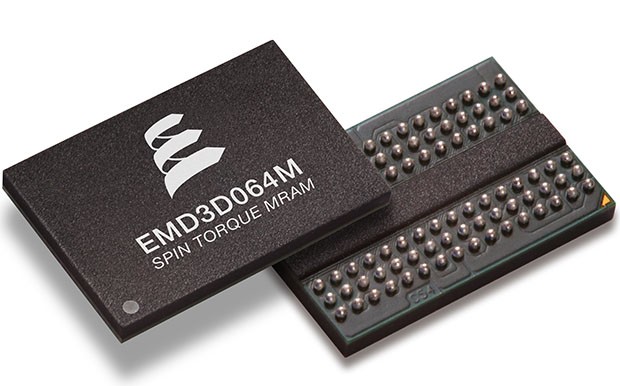Everspin Rolls Out Non-Volatile Replacement Option for DRAM
There has been growing interest in DRAMs that do not lose their content when the power to them is cut.
One explored option is the combination of DRAM with Flash on one chip, but another technology could become much more interesting for those who require performance over capacity. ST-MRAM, or Spin-Torque MRAM.
Everspin just announced its first ST-MRAM, built in a DDR3 form factor module. The device is compatible with the JEDEC DDR3 1600 specification with a "memory bandwidth of up to 3.2 GBytes/second at nanosecond class latency". Samples of the modules are available now and volume shipments are expected for 2013.
Interestingly, MRAM has been positioned for more than a decade as a potential higher-performance replacement for NAND Flash, due to its non-volatile characteristics. However, the technology is too far away from being able to compete on a capacity level - even this new chip has just 64 Mb (8 MB) capacity. In fact, Everspin is currently producing the only commercially available MRAM chips, which hold only 4 Mb and are produced in an antiquated 180 nm process. Remember, Intel's latest CPUs are built in 22 nm.
The upside, however, is MRAM's performance as well as its low power consumption. The memory technology can outpace not only Flash, but DRAM as well and is seen to be operating on the same level as SRAM. With some investment and product demand, MRAM may have an opportunity to appear on the big stage.
Contact Us for News Tips, Corrections and Feedback
Get Tom's Hardware's best news and in-depth reviews, straight to your inbox.

Douglas Perry was a freelance writer for Tom's Hardware covering semiconductors, storage technology, quantum computing, and processor power delivery. He has authored several books and is currently an editor for The Oregonian/OregonLive.
-
freggo Before you all start posting about how 'useless' an 8MB chip is...Reply
My First PC had 64KB (yes, that is a 'K') memory and a 5MB hard drive in full height 5 1/4" format.
Darn thing cost a month' salary too.
Anyway, this type chip technology has obviously some ways to go to find it's way into regular PCs, but there are all sorts of intermediate applications in the low power segment of the market that I can see for them in the very near future.
-
A Bad Day And also, we're talking about a brand-new memory system that has relatively little limit on how much it can be improved (other than financial investments). Flash and DRAM had a obviously huge headstart, but both are reaching a limit on how much they can improved before you have to make sacrifices.Reply
Flash, like the CPUs, is hitting a limit on how far silicon can go. DRAM is also increasingly having less of its silicon dies reserved for actual memory storage and more for other functions such as interconnects. -
ojas I would assume that a comparison to 25nm (or less) NAND would be a better comparison than Intel's 22nm process for tri-gate transistors...Reply -
merikafyeah I never fully understood the word "torque" when it was used with automobiles, and I certainly don't now, when it is used with DRAM.Reply
Someone explain it to me like you would an 8-year-old. -
tmk221 Cleary this tech needs a lot of investment in shrinking the process. It's great that they actually build that chip, even if it's only 8MB. Because now it's a real deal, not some far far away concept. This will lure some investors for sure. And with Dram prices on all the time low, everyone could afford lighting-fast:) RAM driveReply
good luck guys, keep this up, can't wait for mainstream version! -
Robert Pankiw merikafyeahI never fully understood the word "torque" when it was used with automobiles, and I certainly don't now, when it is used with DRAM. Someone explain it to me like you would an 8-year-old.I honestly have no idea how they mean torque in this context, but torque is a rotational force. If you have a long, 'I' shaped bar, and you use one end to stop it from moving, and you use a machine to turn the other end, you are applying a torque. It doesn't always sound all that inviting, I mean, why not just call it a force? Well it is different than a regular force because things react differently to torque (there are whole suspension systems in cars that use torque). In the end, though, it is just another force.Reply -
A Bad Day erraticfocusHey Intel, get in there with some investment monies!Reply
Intel: Nope, too busy trying to beat down ARM and delivering the finishing blows to AMD. -
A Bad Day ojasI would assume that a comparison to 25nm (or less) NAND would be a better comparison than Intel's 22nm process for tri-gate transistors...Reply
Still, any silicon process lower than 40nm is hitting the limits of physics. -
DRosencraft MRAM is a definite possibility for SSD technology's future. It has everything that you would be looking for in the next chip technology.Reply
But I still question its use as system memory as opposed to system storage. I get the functional use - not losing stuff in the memory when the system looses power, whether by power outage or shutdown. But I still think the focus would be better applied to improved read/write performance between the memory and the storage device. If the idea is for all the information to eventually be placed on the storage device, it seems a little strange to me to make memory into a pre-storage device to write to a primary storage device. I only mention this all because a similar story a few days ago was walking about memory chips that could story data for years after loss of power.
